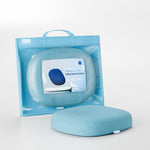Cervical Straightening: Symptoms, Causes and Treatment Solutions

In today's world, the long hours almost everyone spends on their mobile phones with their heads tilted downward unfortunately affects our spine and especially the neck region negatively. We will inform you about "cervical straightening," which is one of the consequences of this situation.
What is Cervical Straightening?
Cervical straightening refers to the loss of the normal curvature in the neck. Normally, the cervical spine shows a slight "C"-shaped curve when viewed from the side, and this condition helps the spine absorb loads and balance the head. However, in some cases, this curvature may decrease or disappear completely, which is called "cervical straightening."
Cervical straightening can generally occur due to reasons such as prolonged poor posture, aging, osteoporosis, trauma, muscle tension, or degenerative disc disease. Additionally, conditions such as prolonged mobile phone or computer use can also lead to cervical straightening, as these types of activities typically cause the head to tilt forward and the normal curvature of the cervical spine to be lost.
Symptoms can generally include neck pain and stiffness, headaches, shoulder pain, and sometimes numbness or tingling in the arm or hand. Treatment typically includes posture correction, physical therapy and exercises, medications to control pain and inflammation, and sometimes surgery. It's important to consult with a healthcare professional before starting treatment.
What Are the Symptoms of Cervical Straightening?
Neck Pain: This is usually the most common symptom of cervical straightening. The pain is typically felt in the neck area and can sometimes radiate to the shoulders and arms.
Stiffness: People with cervical straightening usually feel stiffness in their neck or shoulders.
Headaches: Cervical straightening can sometimes cause headaches.
Muscle Spasms: There may be spasms or tension in the neck muscles.
Limited Range of Motion: People with cervical straightening usually cannot move their necks fully.
Numbness or Tingling: This condition can occur when there is pressure on the nerves in the neck and usually radiates to the arms or hands.
These symptoms typically develop over time due to postural disorders, fatigue, or stress. If you're experiencing neck pain, stiffness, or limited movement, it's important to consult with a healthcare professional. Cervical straightening can usually be treated through posture correction and specific exercises, but in some cases, medication or surgical treatment may be necessary.
What Are the Causes of Cervical Straightening?
Cervical straightening can occur as a result of various factors. Here are some common causes:
Determining the exact cause of cervical straightening usually requires a doctor's examination. If you're experiencing neck pain, stiffness, or limited movement, it's important to consult with a healthcare professional.
Solution Against Cervical Straightening with FOAMSLEEP Premium Contour Pillow
If you're experiencing symptoms of cervical straightening or want to prevent this condition, FOAMSLEEP's Premium Contour Pillow can be a good solution. The Premium Contour Pillow provides anatomical support to the neck area and prevents the formation of cervical straightening. For those who spend long hours at the computer, the Premium Contour Pillow can be a great helper.
Cervical straightening can reduce your quality of life. However, you can prevent this condition by maintaining proper posture and using a pillow that will support your neck area. FOAMSLEEP's Premium Contour Pillow is one of the best ways to protect your neck health.
To maintain a healthy lifestyle and prevent cervical straightening, you too should use the FOAMSLEEP Premium Contour Pillow. Experience the therapeutic benefits of proper cervical alignment and discover why healthcare professionals recommend our ergonomic sleep solutions.
For more information about our scientifically designed sleep products, visit fomsleep.com.
Disclaimer: This information does not constitute medical advice. Please consult with a healthcare professional for proper diagnosis and treatment.




